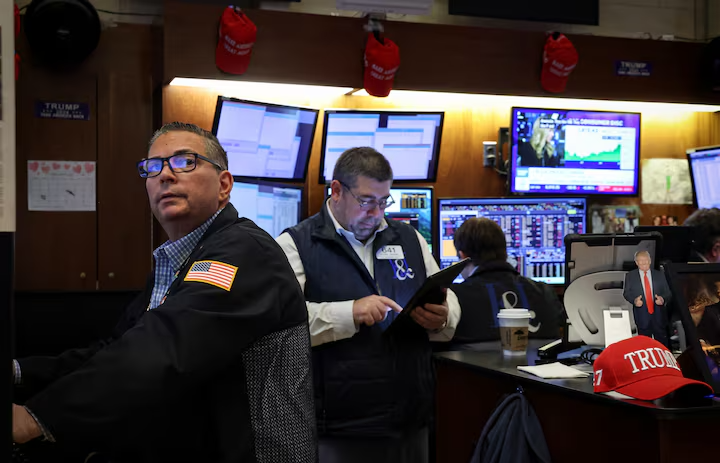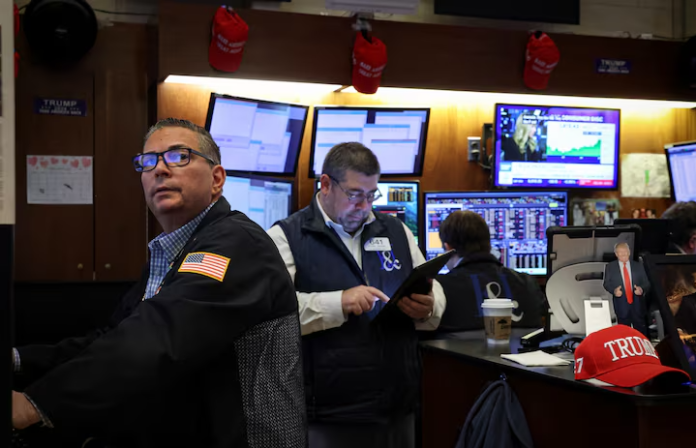The U.S. stock market is experiencing a historic downturn, with investor fears over President Donald Trump’s tariff policies wiping out a staggering $4 trillion in market value. The S&P 500 has dropped over 8% from its record high last month, while the Nasdaq has officially entered correction territory, falling more than 10% from its December peak.
Market Panic: Stocks Suffer Steep Losses
Monday’s sell-off was one of the most severe market declines in recent years. The S&P 500 tumbled 2.7%, marking its biggest single-day drop in 2025. The Nasdaq Composite plunged 4%, its worst daily performance since 2022. Tech stocks were hit particularly hard, with Tesla losing a jaw-dropping $125 billion in value in a single day.
“We’ve seen a clear shift in investor sentiment,” said Ayako Yoshioka, senior investment strategist at Wealth Enhancement. “What worked before isn’t working now, and uncertainty is driving people away from risk assets.”
Tariff War Sparks Economic Concerns
The recent stock market plunge follows a wave of tariff escalations by the Trump administration. Investors are increasingly worried that ongoing trade disputes with key partners like Canada, Mexico, and China could tip the U.S. economy into a recession.
Trump declined to make any predictions about a potential economic downturn, but financial experts warn that prolonged trade tensions could have dire consequences. “The uncertainty created by these tariff wars is forcing businesses to rethink their strategies,” said Peter Orszag, CEO of Lazard. “If these issues aren’t resolved soon, the economic damage could be significant.”
Delta Air Lines and Major Tech Stocks Hit Hard
Adding to investor concerns, Delta Air Lines slashed its first-quarter profit forecast by 50%, citing economic uncertainty. This announcement sent its stock plummeting by 14% in after-hours trading. Meanwhile, the tech sector, which had been the driving force behind market gains in 2023 and 2024, is struggling. Apple and Nvidia each lost about 5% on Monday, while Tesla’s 15% plunge was one of the worst declines in its history.
Investors Brace for More Volatility
As investors seek safety, riskier assets like Bitcoin also saw steep losses, with the cryptocurrency falling 5%. Defensive sectors like utilities performed better, gaining 1% as traders moved toward safer investments.
With a potential federal government shutdown looming and a key inflation report due this week, the market remains on edge. “The administration appears more willing to accept market volatility and even a recession to push its broader economic agenda,” said Ross Mayfield, an investment strategist at Baird. “That’s a wake-up call for Wall Street.”
Will the Market Recover?

Even after the recent sell-off, stock valuations remain elevated. The S&P 500 is trading at over 21 times its forward earnings estimates—well above its historical average of 15.8. Some analysts believe that the current correction could be the beginning of a longer downturn.
“Hedge funds have reduced stock exposure at the fastest rate in two years,” noted a Goldman Sachs report. “Uncertainty over tariffs, geopolitical tensions, and a shaky economic outlook could trigger an even deeper correction.”
While the market has faced corrections before, the combination of political uncertainty and economic headwinds could make this downturn more severe. Investors are now looking to the administration for signs of policy stability, but until there’s clarity, market volatility is likely to continue.
Final Thoughts
The U.S. stock market is navigating turbulent waters, with Trump’s tariff policies adding fuel to investor anxiety. As businesses, consumers, and Wall Street brace for what comes next, the coming weeks will be critical in determining whether this correction is a temporary setback or the start of a prolonged bear market.



